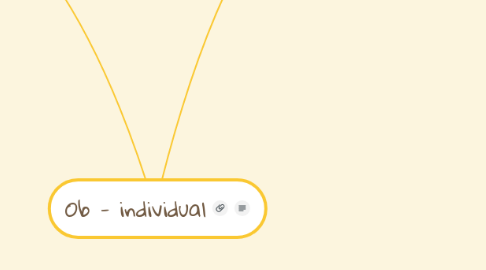
1. diversity
1.1. surface level
1.1.1. age
1.1.1.1. vs. absenteeism
1.1.1.1.1. related. The higher the age, the lower avoidance absence and higher the unavoidance absence
1.1.1.2. vs.productivity
1.1.1.2.1. Unrelated or show better productivity
1.1.1.3. vs. satisfaction
1.1.1.3.1. Depend
1.1.1.4. Discrimination on age. Through a case study 8000 employees
1.1.1.4.1. If yes, lower level of commitment in the company , lower level of organization performance
1.1.1.4.2. If no, vice versa.
1.1.2. sex
1.1.2.1. vs. absenteeism/turnover
1.1.2.1.1. 500,000 professionals higher turnover and absenteeism of women than men
1.1.2.1.2. Parents are rated lower in job commitment, achievement striving and dependability than individuals ( status)
1.1.2.2. vs. harrasment
1.1.2.2.1. If yes, high level of psychological stress - lower org. commitment & job satisfaction - higher turnover rate
1.1.2.3. Discrimination on sex
1.1.2.3.1. Maybe lower performance
1.1.3. Race ðnicity
1.1.3.1. Productivity
1.1.3.1.1. Probably yes if creating a positive climate for diveristy
1.1.4. Disability
1.1.5. Other biographical Characteristics
1.1.5.1. Tenure - Seniority
1.1.5.1.1. Vs. absenteeism
1.1.5.1.2. vs. turnover
1.1.5.1.3. Vs. satisfaction
1.1.5.1.4. productivity
1.1.5.2. Religion
1.1.5.2.1. affect but can not measure due to the complexity of the belief systems.
1.1.5.3. Sexual orientation
1.1.5.3.1. Same as all above
1.1.6. Ability
1.1.6.1. Intellectual Thinking Reasoning Problem solving
1.1.6.1.1. vs. Satisfaction
1.1.6.1.2. Wonderlic measure - Hiring deicison
1.1.6.2. Physical
1.1.6.2.1. vs. absenteeism/ vs. turnover vs. satisfaction vs. productivity
1.2. deep level
1.2.1. Personality
1.2.1.1. Def: dynamic organization within the individual of those psychophysical system that determine his unique adjustments to his environment
1.2.1.2. Composing parts
1.2.1.2.1. Nature - Heredity
1.2.1.2.2. Nurture - Enviroment
1.2.1.3. Measuring
1.2.1.3.1. Self report survey
1.2.1.3.2. Observer rating reports
1.2.1.3.3. Better to combine 2
1.2.1.4. Measuring person traits happens in a large amount of people
1.2.1.4.1. MBIT Myers Briggs Type Indicator Valuable tools for self awareness and career guidance
1.2.1.4.2. The Five Factor Model Robert McCare & Paul Costa
1.2.1.4.3. Other personality traits
1.2.1.5. How to apply understanding in org?
1.2.1.5.1. Choose high conscientiousness candidate for job performance or any other traits depending on org. criteria
1.2.1.5.2. Use other personality traits as tool for employees to understand themselves and for group to understand each other to avoid conflicts
1.2.2. Values
1.2.2.1. Def: a specific mode of conduct or end-state of existence is personally or socially preferable to an opposite or converse mode of conduct or end-state of existence
1.2.2.2. Component
1.2.2.2.1. Content
1.2.2.2.2. Intensity
1.2.2.3. Characteristics
1.2.2.3.1. Stable
1.2.2.3.2. enduring
1.2.2.4. Types
1.2.2.4.1. Terminal - final like freedom, health and well being
1.2.2.4.2. Instrumental - support terminal like self improvement, kindness, goal orientation
1.2.2.5. Application
1.2.2.5.1. Check the personal values vs. corporate values
2. Emotions & Moods
2.1. Def
2.1.1. Emotion
2.1.1.1. Intense & short
2.1.1.1.1. 6 universal emo Happiness/Surprise/Fear Sadness/Anger/Disgust
2.1.2. Mood
2.1.2.1. Not intense but longer
2.1.2.1.1. Possitive
2.1.2.1.2. Negative
2.2. Causes
2.2.1. External reason:
2.2.1.1. Time of the day (3pm)/week (Sat)
2.2.1.2. Weather: no
2.2.2. Internal reasons
2.2.2.1. Sex: women are more emotionally
2.2.2.2. Age: the older, the more positive
2.2.2.3. Exercise: yes, most beneficial for depressed
2.2.2.4. Stress: affect mood and experience more negative emotions
2.2.2.5. Sleep: affect the mood
2.2.2.6. Personality
2.2.2.7. Social acitivites
2.2.3. Emotional dissonance
2.2.3.1. Felt emotion different displayed emotion caused stress - affect the performance
2.3. Effects
2.3.1. 1. Decision making - related 2. Creativity 3. Motivation 4 Leadership 5 Negotiation 6. Customer services 7 Job attitude 8 Deviant Work place behavior 9 Safety Injury at work
2.4. How to improve
2.4.1. RULER
2.4.1.1. Regonizing emotion in self and other
2.4.1.2. Understanding cause and consequences of emotions
2.4.1.3. Labelling emotion accurately
2.4.1.4. Expressing emotion approriately
2.4.1.5. Regulating emotions effectively
